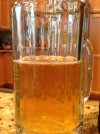How to Make Hard Cider From Whole Apples, Without a Press
.
How to Make Hard Cider From Whole Apples
What You’ll Need:
•Apples, pears, or crab apples (to be mixed with sweet apples.) About 15 lbs. of fruit gets us about a gallon of juice. Must be fresh and organic. We just use foraged fruit. Try to include some crab apples or tart apples with your sweet ones for a better, more balanced flavor.
•A juicer. If I could do it all over again, I would probably buy a masticating juicer which would make the process easier. But any juicer will work!
•A chopping knife and cutting board.
•A large sieve and a clean kitchen towel.
•Demijohn(s), a funnel, a siphon hose, rubber stoppers, and airlocks. Some people simply stretch a balloon with a pin prick in it over the demijohn instead of using an airlock. This is one of the easiest brewing projects, in terms of equipment needed.
•Sugar (I like to use organic brown sugar.)
•Swing-top bottles.
What to Do:
1.Wash your fruit well with water. I don’t use any vinegar or veggie wash because I want to keep the yeast on the skins on the apples.
2.Cut your apples into quarters. This is mostly just to check for bugs or other issues with the apples. Discard or cut around any that have an infested core, and cut out major bruises. It’s nice to have a partner for this part, and it’s the perfect job for a kid with basic knife skills. But I have done it by myself, too. Transfer chopped fruit to a clean bowl by your juicer. You don’t need to worry about coring or taking stems out– the juicer will do that for you.
3.Start juicing! As your juicer pitcher gets full, pour it through a funnel into a sterilized demijohn.
4.When the pulp container starts getting full, take a few minutes to squeeze the juice out of the pulp. Place your sieve over a clean bowl, and line it with your kitchen towel. Put a couple heaping handfuls of pulp in the towel, and gather the edges and twist to wring out as much of the juice as possible. My own juicer is not great, so I actually get 50% of the total juice this way. Your pulp (now called pommace) should be really dry when you’re done, and you can just compost it. Pour the juice into the demijohn, and get back to juicing.
5.Once you have juiced all of your fruit, taste the juice and add sugar. This is where a little guesswork will come in, because the acidity and tannin content, as well as the sweetness of your fruit will vary. I usually add about a cup of sugar to a gallon of juice, and I don’t like mine very sweet. During the fermentation process, the yeast will eat the sugar (both the fructose from the fruit and the added sugar) and turn it into alcohol– so this step is both for flavor and alcohol level. Those of you in the USA may not really need to add much sugar, as most of the apples there tend to be really sweet. Don’t get hung up on this step, as you can add more sugar later if the brew is turning out too dry or tart for your taste.
6.(This step is optional, depending on whether you have a lot of foam/ pulp floating at the top of your demijohn.) Put your demijohn on a tray or in a bowl, and keep it in a warm spot for about a day or so. The yeast will start to become active, and things will get bubbly. Your cider will split into layers, with foam floating on top. If your demijohn is pretty full, the foam will come out the top. I think this is great, as it’s a good way to get rid of that funky stuff.
7.Put a rubber stopper and an airlock on your demijohn, and let it sit for a week.
8.Rack your cider— siphon it into another sterilized demijohn, leaving the yeasty sediment in the bottom of the first one, so you have a much cleaner cider in the new demijohn. Taste it and see how it’s doing. If it’s already tasting pretty dry, you can add some more sugar before you put the airlock back on.
9.Some people like a pretty sweet cider, and bottle it after a week. I like mine pretty dry, tart and strong, so I usually give it three weeks or even more. Fermenting it this long means that it won’t be very fizzy in the end– but you can also add a little sugar just before bottling to regain some carbonation. This is totally up to you, of course. You could experiment and bottle half to drink and leave the rest for another week. Whatever you decide, the next step is to bottle your hard cider. Use the siphon hose to fill swing-top bottles. The type of bottle is really important, since it lets out small amounts of the pressure that builds up, so you don’t have a glass explosion


